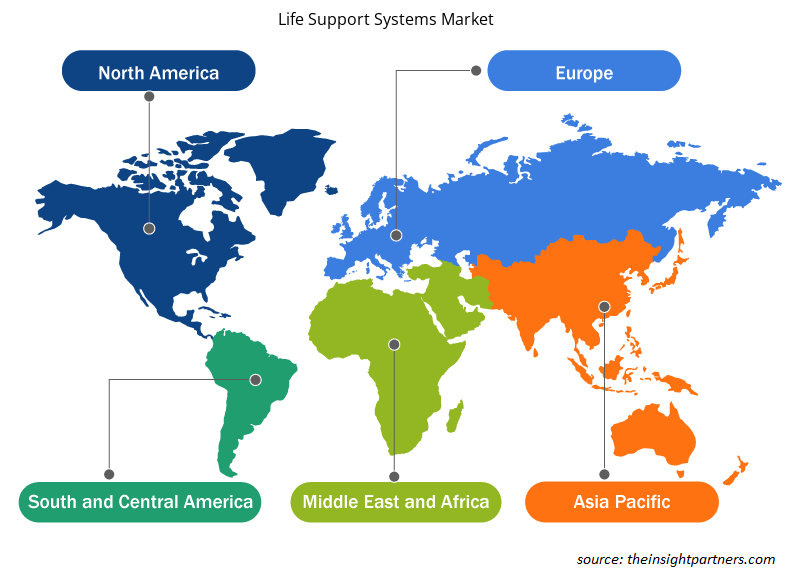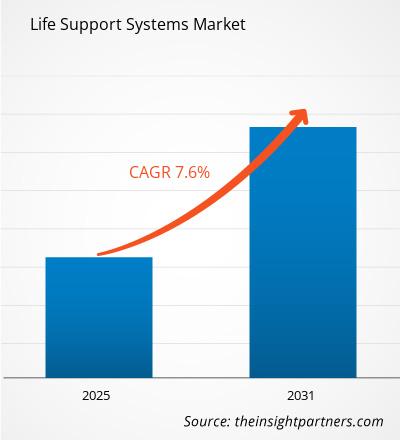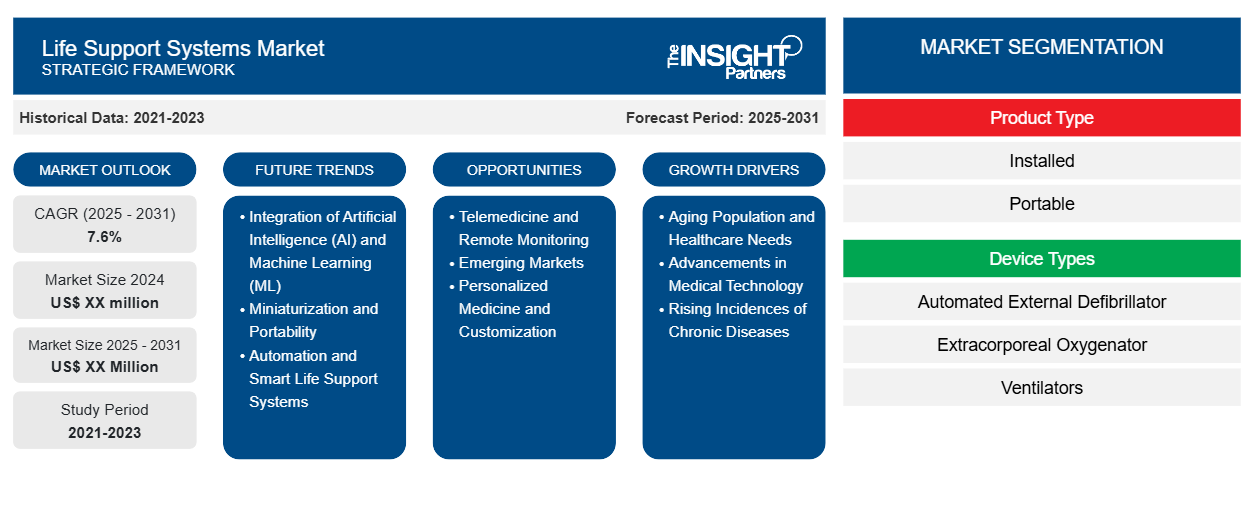生命支持系统市场预计在 2023 年至 2031 年期间的复合年增长率为 7.6%,市场规模将从 2023 年的 XX 百万美元扩大到 2031 年的 XX 百万美元。
报告按产品类型(安装式、便携式)细分。报告进一步根据设备类型(自动体外除颤器、体外 氧合器、呼吸机、其他)进行分析。报告按最终用户(医院、诊所、创伤中心、其他)细分。全球分析进一步细分为区域和主要国家。报告提供上述分析和细分的美元价值。
报告目的
Insight Partners 撰写的《生命支持系统市场》报告旨在描述当前形势和未来增长、主要驱动因素、挑战和机遇。这将为各种业务利益相关者提供见解,例如:
- 技术提供商/制造商:了解不断变化的市场动态并了解潜在的增长机会,从而能够做出明智的战略决策。
- 投资者:对市场增长率、市场财务预测以及整个价值链中存在的机会进行全面的趋势分析。
- 监管机构:监管市场政策和警察活动,旨在最大限度地减少滥用行为,维护投资者的信任和信心,维护市场的完整性和稳定性。
生命支持系统市场细分
产品类型
- 已安装
- 便携的
设备类型
- 自动体外除颤器
- 体外 氧合器
- 呼吸机
- 其他的
最终用户
- 医院
- 诊所
- 创伤中心
- 其他的
地理
- 北美
- 欧洲
- 亚太
- 南美洲和中美洲
- 中东和非洲
地理
- 北美
- 欧洲
- 亚太
- 南美洲和中美洲
- 中东和非洲
定制此报告以满足您的需求
您可以免费定制任何报告,包括本报告的部分内容、国家级分析、Excel 数据包,以及为初创企业和大学提供优惠和折扣
- 获取此报告的关键市场趋势。这个免费样品将包括数据分析,从市场趋势到估计和预测。
生命支持系统市场增长动力
- 人口老龄化和医疗保健需求:生命支持系统市场是全球人口老龄化激增的主要因素之一,因为寿命的延长使得越来越多的人需要有助于管理慢性病和重症监护的医疗设备。在重症监护室和其他重症监护室使用生命支持系统对老年患者进行最不可或缺的治疗包括呼吸机、透析机和心肺机。人口结构的变化推动了创新技术的发展,同时也推动了更强大、更可靠、更高效的生命支持系统的发展。
- 医疗技术的进步:生命支持系统市场的关键增长因素之一仍然是生物医学工程的进步。小型化和便携式设备、先进的监测设备和用于预测某些问题的人工智能集成等救生技术提高了生命支持技术的有效性和可靠性。因此,这些仪器可能会改善患者的治疗效果,提高各种临床情况下生命支持的可及性,从而为市场的增长创造进一步的动力。
- 慢性病发病率上升:考虑到这一问题,呼吸系统疾病、心血管疾病和肾衰竭等慢性病的发病率不断上升,这表明医院和诊所对生命支持系统的需求应该增加。机械呼吸机、体外膜氧合 (ECMO) 机和人工肾系统等设备主要用于处理危及生命的情况。慢性病病例数量的增加是此类关键卫生技术需求增加的一个重要因素。
生命支持系统市场未来趋势
- 人工智能 (AI) 与机器学习 (ML) 的融合:这些技术通过考虑实时呈现并改善患者结果,增强了通气、ECMO 机器等的可预测性,已成为生命支持的主要趋势之一。可以通过使用 AI 分析大量医疗数据并预测并发症来评估这一结果,从而实现生命支持设置的最佳调整。
- 小型化和便携性:另一个普遍趋势是生命支持系统变得更小,更注重便携性和可用性。例如,制造便携式呼吸机和氧气浓缩器的努力脱颖而出;虽然这些设备曾经可能只在救护车服务、家庭护理和紧急服务环境中有用,但它们可以变得更小、更便携。这通常使生命支持技术更容易为用户所用,也更难承受恶劣的环境条件。
- 自动化和智能生命支持系统:基于实时数据的智能机器和自我校正系统可确保正确及时地提供护理,这是生命支持系统自动化逐渐成为常态的另一个领域。例如,在呼吸机中,智能模型可以通过根据患者的呼吸模式更改设置来自动设置其参数。自动化减少了生命支持系统的人工投入,从而使重症监护情况下的护理快速而准确。
生命支持系统市场机会
- 远程医疗和远程监控:远程医疗现在拥有远程监控的生命支持系统,这使得它能够部署在最偏远和服务最欠缺的环境中。因此,医疗服务提供商可以从任何地方甚至从更偏远或服务欠缺的环境中实时监控所有生命体征,例如血氧饱和度和心率等。当然,物联网技术与生命支持系统的这种整合将为农村或发展中地区带来前所未有的机会,这些地区通常无法获得传统医疗设施。
- 新兴市场:这是生命支持系统市场的一个开放机会,新兴经济体的医疗保健基础设施正在不断扩大。印度、中国和巴西等国家的医疗保健结构中新系统和旧系统的升级带来了对先进医疗设备的需求。制造商可以利用符合当地需求的低成本、可靠的生命支持系统来开拓这个不断增长的市场。
- 个性化医疗和定制:个性化医疗的进步为为个体患者量身定制生命支持系统打开了大门。例如,呼吸机可能具有针对患有某些特定疾病的患者量身定制的一些特殊设置。同样,患者可能需要定制透析治疗计划或氧气治疗。提供个性化解决方案的能力可能会为患者带来更好的治疗效果,并激发人们对更复杂的生命支持设备的兴趣。
生命支持系统市场区域洞察
Insight Partners 的分析师已详尽解释了预测期内影响生命支持系统市场的区域趋势和因素。本节还讨论了北美、欧洲、亚太地区、中东和非洲以及南美和中美洲的生命支持系统市场细分和地理位置。

- 获取生命支持系统市场的区域特定数据
生命支持系统市场报告范围
| 报告属性 | 细节 |
|---|---|
| 2023 年的市场规模 | XX 百万美元 |
| 2031 年市场规模 | XX 百万美元 |
| 全球复合年增长率(2023 - 2031) | 7.6% |
| 史料 | 2021-2022 |
| 预测期 | 2024-2031 |
| 涵盖的领域 | 按产品类型
|
| 覆盖地区和国家 | 北美
|
| 市场领导者和主要公司简介 |
|
生命支持系统市场参与者密度:了解其对业务动态的影响
生命支持系统市场正在快速增长,这得益于终端用户需求的不断增长,而这些需求又源于消费者偏好的不断变化、技术进步以及对产品优势的认识不断提高等因素。随着需求的增加,企业正在扩大其产品范围,进行创新以满足消费者的需求,并利用新兴趋势,从而进一步推动市场增长。
市场参与者密度是指在特定市场或行业内运营的企业或公司的分布情况。它表明在给定市场空间中,相对于其规模或总市场价值,有多少竞争对手(市场参与者)存在。
在生命支持系统市场运营的主要公司有:
- 史赛克公司
- 海尔医疗股份公司
- 荷兰皇家飞利浦公司
- 瑞士哈美顿医疗公司
- ZOLL 医疗公司
免责声明:上面列出的公司没有按照任何特定顺序排列。

- 获取生命支持系统市场顶级关键参与者概览
主要卖点
- 全面覆盖:报告全面涵盖生命支持系统市场的产品、服务、类型和最终用户的分析,提供整体概况。
- 专家分析:报告基于对行业专家和分析师的深入了解而编写。
- 最新信息:该报告涵盖了最新信息和数据趋势,确保了其与业务的相关性。
- 定制选项:此报告可以定制以满足特定客户要求并恰当地适应业务策略。
因此,生命支持系统市场研究报告有助于引领解读和了解行业情景和增长前景。尽管可能存在一些合理的担忧,但本报告的总体优势往往大于劣势。
- 历史分析(2 年)、基准年、预测(7 年)及复合年增长率
- PEST和SWOT分析
- 市场规模、价值/数量 - 全球、区域、国家
- 行业和竞争格局
- Excel 数据集
近期报告
客户评价
购买理由
- 明智的决策
- 了解市场动态
- 竞争分析
- 客户洞察
- 市场预测
- 风险规避
- 战略规划
- 投资论证
- 识别新兴市场
- 优化营销策略
- 提升运营效率
- 顺应监管趋势





















 获取免费样品 - 生命支持系统市场
获取免费样品 - 生命支持系统市场